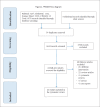The Use of Telemedicine in Surgical Care: a Systematic Review
- PMID: 30515013
- PMCID: PMC6195401
- DOI: 10.5455/aim.2018.26.201-206
The Use of Telemedicine in Surgical Care: a Systematic Review
Abstract
Introduction: Telemedicine describes a healthcare service where physicians communicate with patients remotely using telecommunication technologies. Telemedicine is being used to provide pre-/postoperative surgical consultation and monitoring as well as surgical education.
Aim: Our purpose was to investigate the broad range of telemedicine technologies used in surgical care.
Material and methods: MEDLINE, EMBASE, CINAHL, and Science Direct were searched for available literature from inception to March 30, 2018 with no language restrictions. The search terms included: cell phones, telemedicine, telecommunications, video, online, videoconferencing, remote consultation, surgery, preoperative, perioperative, postoperative, and surgical procedures. Studies were included if they used telemedicine in surgery for pre-, peri-, or post-surgery periods, and if they compared traditional surgical care with surgical telemedicine. We excluded case series, case reports, and conference abstracts from our review.
Results: A total of 24 studies were included in our review. The study found that the use of telemedicine in preoperative assessment and diagnosis, evaluation after surgery and follow-up visits to be beneficial. Patients reported benefits to using telemedicine such as avoiding unnecessary trips to hospitals, saving time and reducing the number of working days missed.
Conclusion: Telemedicine in surgical care can provide benefits to both patients and.
Keywords: Telemedicine; monitoring; satisfaction; surgical procedure.
References
-
- Dasgupta P, Challacombe B. Robotics in urology. BJU International. 2004;93(3):247–248. - PubMed
-
- Challacombe B, Dasgupta P. Telemedicine - the future of surgery. The Journal of Surgery. 2003;1(1):15–17.
-
- Field MJ. National Academies Press; 1996. Telemedicine: A guide to assessing telecommunications for health care. - PubMed
-
- Aziz SR, Ziccardi VB. Telemedicine using smartphones for oral and maxillofacial surgery consultation, communication, and treatment planning. Journal of Oral and Maxillofacial Surgery. 2009;67(11):2505–2509. - PubMed
-
- Gosman AA, Fischer CA, Agha Z, Sigler A, Chao JJ, Dobke MK. Telemedicine and surgical education across borders: a case report. Journal of surgical education. 2009;66(2):102–105. - PubMed
Publication types
LinkOut - more resources
Full Text Sources
Medical

